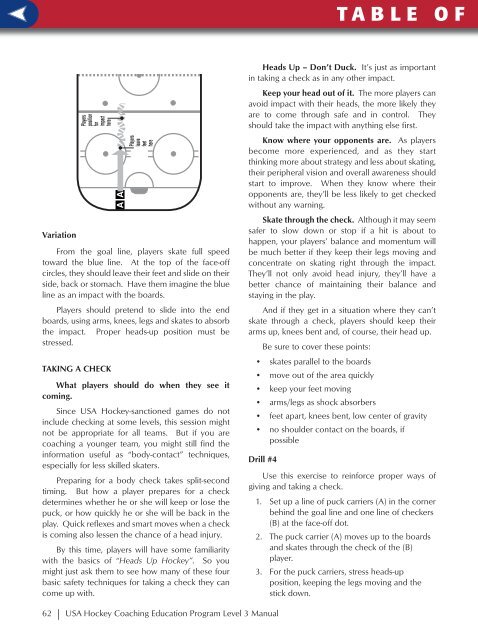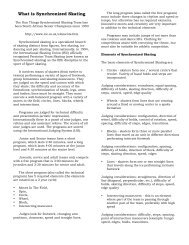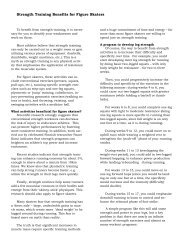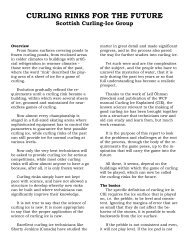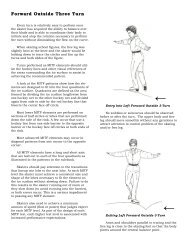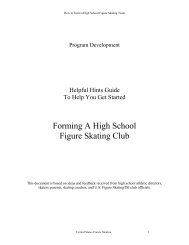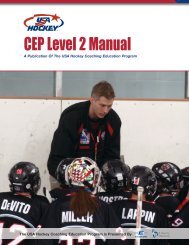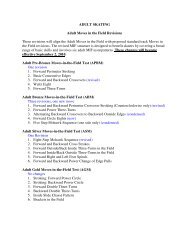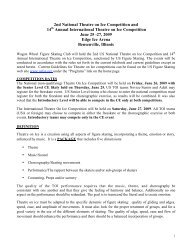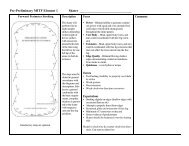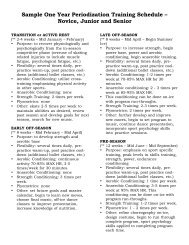CEP Level 3 Manual - Rushmore Hockey Association
CEP Level 3 Manual - Rushmore Hockey Association
CEP Level 3 Manual - Rushmore Hockey Association
You also want an ePaper? Increase the reach of your titles
YUMPU automatically turns print PDFs into web optimized ePapers that Google loves.
T A B L E O F C O N T E N T SVariationPlayerspositionfor impacthereFrom the goal line, players skate full speedtoward the blue line. At the top of the face-offcircles, they should leave their feet and slide on theirside, back or stomach. Have them imagine the blueline as an impact with the boards.Players should pretend to slide into the endboards, using arms, knees, legs and skates to absorbthe impact. Proper heads-up position must bestressed.TAKING A CHECKA APlayersleavefeethereWhat players should do when they see itcoming.Since USA <strong>Hockey</strong>-sanctioned games do notinclude checking at some levels, this session mightnot be appropriate for all teams. But if you arecoaching a younger team, you might still find theinformation useful as “body-contact” techniques,especially for less skilled skaters.Preparing for a body check takes split-secondtiming. But how a player prepares for a checkdetermines whether he or she will keep or lose thepuck, or how quickly he or she will be back in theplay. Quick reflexes and smart moves when a checkis coming also lessen the chance of a head injury.By this time, players will have some familiaritywith the basics of “Heads Up <strong>Hockey</strong>”. So youmight just ask them to see how many of these fourbasic safety techniques for taking a check they cancome up with.Heads Up – Don’t Duck. It’s just as importantin taking a check as in any other impact.Keep your head out of it. The more players canavoid impact with their heads, the more likely theyare to come through safe and in control. Theyshould take the impact with anything else first.Know where your opponents are. As playersbecome more experienced, and as they startthinking more about strategy and less about skating,their peripheral vision and overall awareness shouldstart to improve. When they know where theiropponents are, they’ll be less likely to get checkedwithout any warning.Skate through the check. Although it may seemsafer to slow down or stop if a hit is about tohappen, your players’ balance and momentum willbe much better if they keep their legs moving andconcentrate on skating right through the impact.They’ll not only avoid head injury, they’ll have abetter chance of maintaining their balance andstaying in the play.And if they get in a situation where they can’tskate through a check, players should keep theirarms up, knees bent and, of course, their head up.Be sure to cover these points:• skates parallel to the boards• move out of the area quickly• keep your feet moving• arms/legs as shock absorbers• feet apart, knees bent, low center of gravity• no shoulder contact on the boards, ifpossibleDrill #4Use this exercise to reinforce proper ways ofgiving and taking a check.1. Set up a line of puck carriers (A) in the cornerbehind the goal line and one line of checkers(B) at the face-off dot.2. The puck carrier (A) moves up to the boardsand skates through the check of the (B)player.3. For the puck carriers, stress heads-upposition, keeping the legs moving and thestick down.4. For the checkers, stress contact with theshoulders, not the head, elbows, knees, stickor feet.5. In this drill, players should alternate frompuck carrier lines (A) to checking lines (B).For best use of your ice time, set up the samedrill in the other corner, too.GIVING A CHECKBBBBAAAASeparating the puck from your opponent, notseparating your opponent from consciousness.As with the previous session, this material maybe less appropriate for younger age levels wherechecking is not allowed, but the information is stillvaluable.<strong>Hockey</strong> rules are specific about a legal bodycheck: it’s when a player checks an opponent whois in possession of the puck, by using hip or shoulderfrom the front, diagonally from the front or straightfrom the side, and does not take more than twosteps/strides in executing the check.”The point is, checks and body contact are notabout intimidation and not about inflicting pain andinjury. They’re just one part of the game, along withskating, shooting, passing, and puck handling.In preparing your team for this “Heads Up<strong>Hockey</strong>” session, start them thinking by discussingthe checking they see in NHL games on TV. Dothey find it exciting? (Definitely). Do they wish theycould give a check like that themselves? (Probably).Now invite them to imagine themselves on thereceiving end of some of those spectacular NHLchecks. Could they take it? Remind your playersthat the checks they see on TV are given and takenby world-class athletes in top form, who have theexperience and control to play physical hockey atthat level.As a coach, the caliber and sportsmanship ofyour team’s play is in your hands. We hope you’llpromote safe, legal checking for your players. Wealso hope you’ll insist on clean, legal checking fromopposing teams, too. It’s another way of keepingyour team safe without suffering any competitivedisadvantages.Checking from BehindIt’s illegal. And it’s extremely dangerous. Even alight hit from behind could inflict a severe head orneck injury.Be sure to tell your players that no matter howintense the game becomes, they must not hitanother player from behind, ever. And, of course,checking from behind exposes your team to thepossibility of a major penalty.A Word About Reckless Play: DUMB!In the heat of the game, players can occasionallyget so psyched up they forget everything they’velearned, and get into a play they have no chance offinishing safely.Some players drive to the net so fast they justcan’t stop, making a dangerous collision practicallya sure thing.You know this is bad hockey and that it isdangerous hockey. The sad truth is, many hockeyinjuries are “self inflicted” by players skating waypast their limits and “going for it” at all costs.Be sure to tell your team that reckless play likethis does nobody any good. It rarely results in a goalor a good play, and often ends up as a penalty, aninjury or both.62 | USA <strong>Hockey</strong> Coaching Education Program <strong>Level</strong> 3 <strong>Manual</strong>Risk Management | 63


